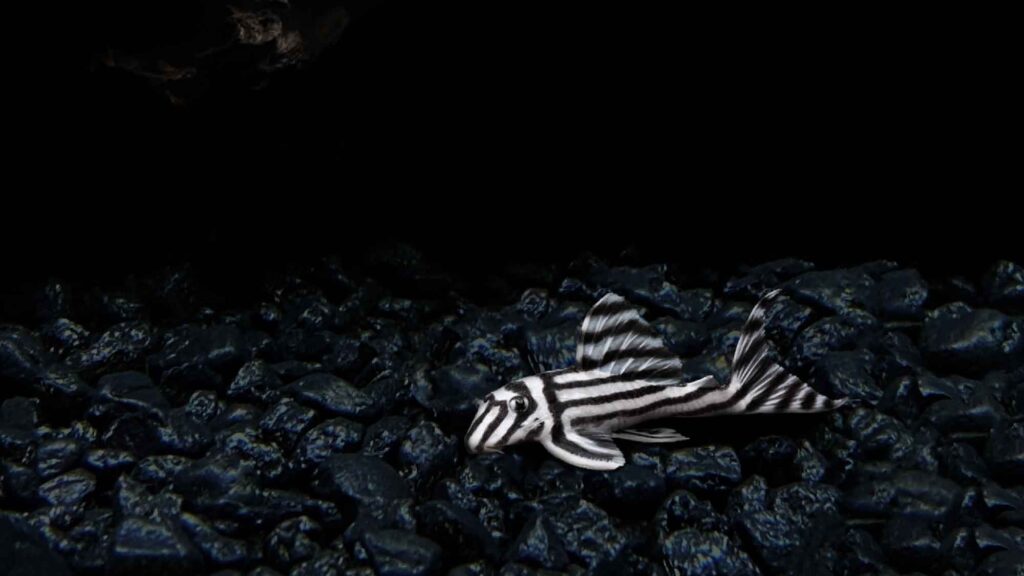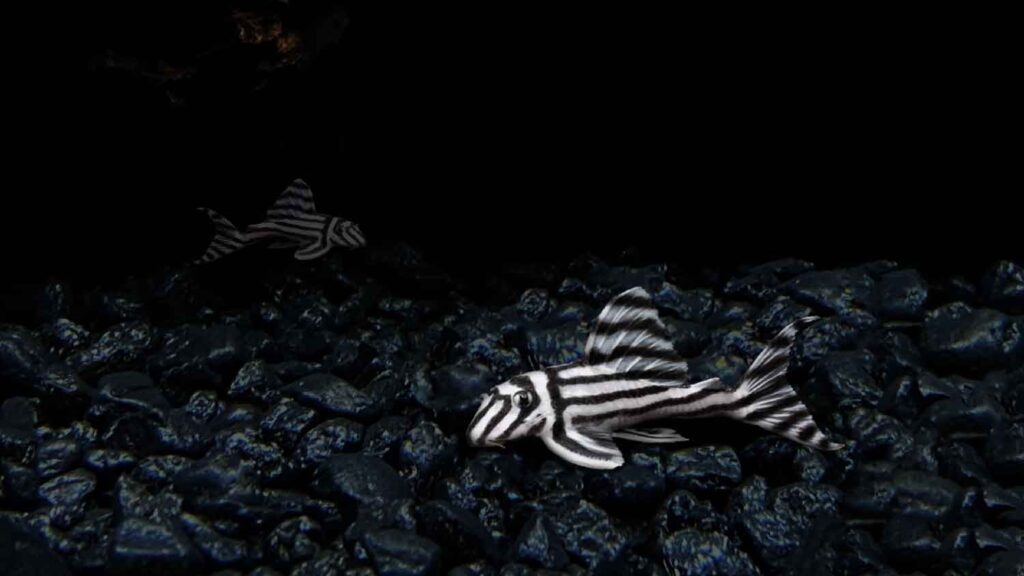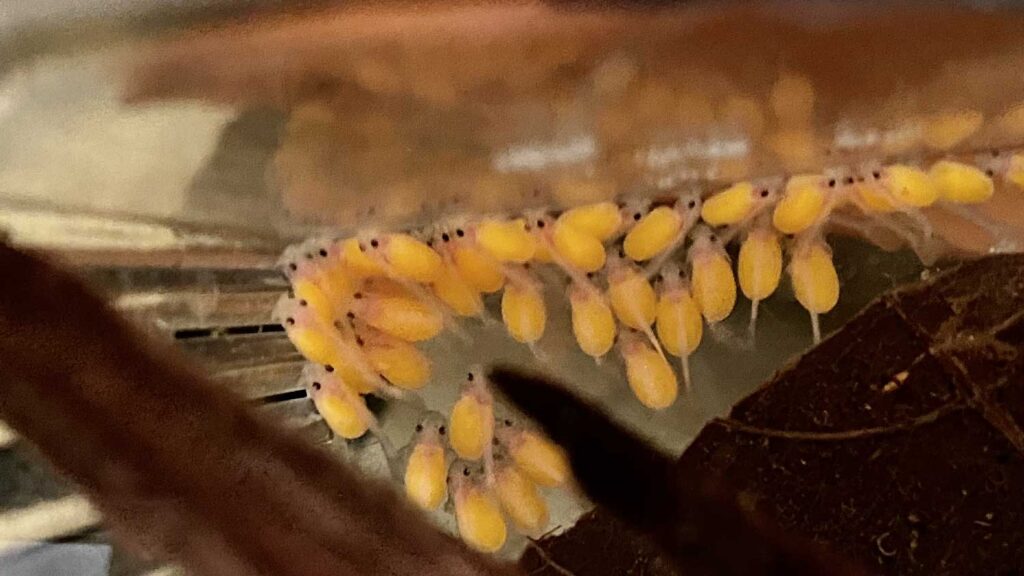Zebra Plecos are unusual-looking freshwater fish that will draw anyone’s attention to the tank and themselves. Their scientific name is Hypancistrus zebra. These delicate, little pleco fish are very sought after species by many aquarists. They are hardy creatures that can survive in a variety of tank conditions. But in order to thrive, these fish require particular water qualities. You will also need to be aware of the dietary and behavioral requirements.
This guide will teach you everything you need to know about caring for a Zebra Pleco. By the end of this article, you will be prepared to bring one of these fish into your home and care for it properly!
Species Profile & Overview
Zebra Pleco (L046 Pleco) is a member of the Loricariidae family (Plecos) that is found only in the big bend of the Xingu River in Brazil. However, this species is kept and locally bred across the world in many countries. These fish have been an aquarium hobby for many years and still attract new hobbyists.
As with other members of this family, L46 zebra plecos have an armoured back that protects them from predators. They have unique black and white markings that are well adapted to the region they live in. These patterns will help them blend into the rocks and white sand in the Xingu River. These unique zebra-like black and white markings make them desirable fish for aquarium lovers. This popularity has become more evident in recent years after they were banned for export in Brazil.
These fish come from oxygen-rich warm waterways with a slightly fast water current. L46 plecos are well adapted to this environment and will thrive when the same conditions are created in a tank.
In the wild, they mainly feed on freshwater sponges, small crustaceans, and low quantities of available plant matter.
These fish are very peaceful and will live at the bottom of the aquarium regardless of what is happening above them. They will also consume any leftover food that other fish may miss.
Appearance:

The L46 pleco has a familiar pleco shape with a bony back. But their unique markings and color set them apart from other related plecos.
Like other fish in this family, this species has a flat body with a bony back. Their mouth is located under their heads, towards the bottom, where they can attach themselves to objects by sucking on them. The eyes and nose are located on top of the head and are the only soft spots on its back.

Same as other fish in the Loricariidae family, Zebra Pleco has beautiful fins that have the same pattern and color as the rest of the body. The dorsal fin is one of the largest fins on its body that is used for maneuvering.
This fish has black and white stripes that cover the entire back of its body. These stripes are stretched on the head and fins. The stripes are very sharp and dark black, which gives the fish the famous zebra look.
This unique-looking fish can be a great addition to your tank as long as the parameters of your tank matches to what L46 needs.
Adult Size
The average Zebra Pleco size is around 3 inches in length when they are fully grown. Males will grow slightly bigger compared to females.
Their small size makes them an excellent option for aquarists seeking a pleco that can live in smaller aquariums. Many plecos reach enormous sizes, making it impossible to keep them in smaller aquariums.
Lifespan
The L46 lifespan in a well-maintained tank is between 10 and 15 years. As with the majority of aquarium fish, these fish will only reach their expected lifespan if they receive proper care and nutrition.
Behavior & Temperament
This fish is a peaceful species of plecos that spends the majority of its time at the bottom of the aquarium. The Zebra Pleco will not interfere with the activities of other aquarium inhabitants and will mind its own business at all times. They are mainly active and search for food during the night.
However, this does not necessarily mean that this fish is only active at night. After some time, you will notice that your pet pleco is frequently out of its favorite hiding spot and swimming even when it’s daytime. This is because your l46 has become accustomed to the tank environment and now feels safe enough to explore the tank.
Males become more territorial when there are more of them in a tank. They will compete for their preferred cave or hiding place. In contrast to males, females are not territorial and will not engage in combat with other males or females.
Increasing the number of pleco caves and hiding places will reduce male’s aggression. You can also move some of the males to a different tank in order to keep the calm in your aquarium.

Zebra Pleco Care
Zebra Pleco care is easy and simple. Even though they originally came from the wild, these fish adapt well to aquarium life. However, you will need to make simple adjustments to your aquarium so these fish can flourish.
Generally, They are low-maintenance fish but we recommend these fish for intermediate to advance aquarists. This is because the l46 plecos are sensitive to fluctuating water parameters.
However, as long as you can keep water parameters constant and give them a good mix of different foods, you shouldn’t face any problems keeping them! To provide your Zebra Pleco with the best environment possible, you should abide by the suggestions listed below.
Tank Size
The minimum tank size for a single Zebra Pleco is 20 gallons. Juvenil l46s can live in smaller aquariums, but you will soon have to upgrade as they grow. In comparison to smaller tanks, larger ones will facilitate your work and maintain more stable parameters.
However, L46 plecos need more floor space than just water volume. More plecos can be kept in a tank with a larger surface area. We recommend having a slightly larger tank if possible. A benefit of larger aquariums is that they have a larger bottom area and maintain more stable parameters.
If you have the option to choose a tank specifically for your plecos, we strongly recommend selecting one that is wide and has a lot more floor area than height. The bottom surface is more significant because plecos do not swim much in the water column but rather remain at the bottom. If you already have a tank and wish to add plecos, you should add one pleco per square foot of the tank’s bottom space (assuming your tank can hold at least 20 gallons of water and no other fish are available).
Tank Setup:
When caring for Zebra Pleco, it’s crucial to adjust the aquarium’s settings to best suit this fish. Keeping your L46 pleco happy and healthy in your tank means mimicking its natural environment as closely as possible. Since these fish spend most of their time near the tank’s bottom, you should pay special attention to the composition of the substrate and any other ornaments you place there.
If you want this fish to feel at home in its tank, you will have to add lots of hiding places. While pleco caves are the best option for this purpose, other options include driftwood, rocks, and slates, which will also create natural hiding places. Adding the natural decorations mentioned above will help you create a more balanced environment for your plecos.
Aquarium sand is the most natural-looking and most comfortable surface for Zebra Plecos to live on. The substrate for these fish should be fine and soft because of their delicate bellies. Sharp substrates could result in wounds that lead to various types of infections. Smaller pea gravels are also acceptable; their rounded, point-less shape will not harm the zebra’s belly. Although they will not be as appealing to fish as sand. Some of the substrates for planted aquariums are also excellent options as they are soft and small in size.
Plants are essential to the health of any ecosystem. Aquatic plants will filter the water of toxins while also giving your fish lots of places to hide. Plants are also a great way to improve the aesthetics and functionality of your aquarium, thus we highly recommend having them in your aquarium.
Water Parameters:
The key to keeping your Zebra Pleco healthy and happy is maintaining consistent water conditions. Any changes to the aquarium’s conditions should be avoided, as this can cause stress and illness in the fish and ultimately shorten their lifespan. They need warm, highly oxygenated waters same as it is in their natural habitat in the Amazon River.
Below are the tank parameters you can keep your zebra plecos in:
- Temperature: 80-86 degrees Fahrenheit
- PH: 6.5-7.0
- TDS: 60-120 PPM
We suggest purchasing a TDS (Total Dissolved Solids) meter along with a test kit in order to maintain stability in your tank. To make sure the water conditions are ideal for your zebra pleco, when you first bring them home, you will need to conduct regular water changes and tests. A TDS meter is required to determine when a water change is necessary. You must change the water in your tank whenever the TDS rises above the ideal level to get the TDS to return to the normal range mentioned above.
Lighting:
In general, Zebra Pleco does better in the shade, so if you don’t have any plants, you should avoid extremely bright lighting. However, If you have live plants in your aquarium, you should add more decorations and hiding places for them to hide when the lights are on.

Filter System:
It’s no secret that plecos, and especially Zebra Plecos, can be quite the waste producers. Therefore, you’ll need a strong filter to guarantee that the water in your tank is always clean.
The L46 plecos are extremely sensitive to even small increases in ammonia levels, so you should invest in the best filtration system you can afford. Having a large filter allows your tank to keep up with waste production and prevent harmful ammonia levels.
Common Diseases and Prevention
Zebra Pleco are hardy fish that do not fall ill easily. However, when the water parameters are not optimal or when they are under stress, they are susceptible to illness. If a newly added fish has a disease or infection, the diseases or parasites will easily spread to your zebra plecos.
Disease prevention is the most painless method of keeping your Zebra Pleco healthy. When you properly maintain your aquarium, you are actively eliminating the majority of the causes that might infect or sicken your fish.
The water quality and diet are the most important aspects of L46 pleco care that determine the fish’s health. Routine water changes and the right diet will drastically reduce the risk of bacterial and fungal infections.
Diet and Feeding Requirements:
Feeding your Zebra Pleco a variety of foods will aid in the development of a robust immune system. These fish are predominantly carnivores (meat eaters), but they also consume small quantities of fresh vegetables, plant matter, algae, and other plant-based foods. Meaty foods should comprise the majority of their daily diet. They must be fed a variety of high-protein foods, including small crustaceans, prepared foods, and insect larvae.
You must provide them with a balanced diet that provides them with all the nutrients they require. As previously stated, these fish are carnivores, so you should provide them with protein based foods. You can provide your pleco with frozen or live bloodworms, brine shrimp, tubifex, daphnia, and other small creatures for protein. These are an excellent source of protein that will also provide a variety of other essential nutrients.
Sinking pellets, shrimp wafers, and algae wafers are some of the best options for your pleco’s regular diet. They are relatively inexpensive and contain the majority of the essential nutrients your fish needs. However, you will need to purchase and feed your pleco a variety of these foods as they each have different ingredients and your zebra plecos need all of them. A mixture of high-protein pellets or fish flakes and a small amount of plant-based foods is an ideal source of nutrition.
While sinking pallets are the primary source of nutrition for your Zebra Pleco, live or frozen foods can be given as snacks a few times per week. To ensure your fish get the proper nutrition, it’s important to offer them a wide range of foods. The L46 are nocturnal species in nature, so feeding them at night is the best approach.
Breeding Zebra Pleco

The process of breeding Zebra Plecos is complicated and can be very frustrating at times. However, it is possible to breed the L46 Zebra Plecos in an aquarium given the right conditions. The more knowledge and experience you have breeding other types of catfish, the better your chance at success with the Zebra Pleco.
If you want to breed these fish, your L046 needs to be at least two to three years old and fully mature before they breed. As soon as you have established that your breeding group contains at least one male and one female, you can start conditioning your fish for reproduction.
L46 zebra plecos are cave breeders, which means they need caves to breed. The cave should be slightly bigger than the male’s body but small enough that he can trap the female inside.
You should provide a cave for each male in your tank if there are multiple males available. Generally speaking, you should place one cave for every male present in the aquarium. The male with the cleanest and most safe cave will attract the female to lay her eggs.
Zebra plecos lay about 15 – 25 eggs depending on the age of the female.
During mating season, males search for caves where they can lure females inside and keep them there. After finding an appropriate cave, the male will prepare it for the arrival of the female by clearing out any debris. When the female is ready to lay eggs, the male will trap her and prevent her from leaving the cave.
Once the eggs have been laid, the male will allow the female to leave the cave so that he can fertilize them. Males are responsible for protecting eggs from predators until they hatch. To prevent the eggs from spoiling or developing mold, the male cleans and fans them during this time.
Depending on the water temperature, the eggs usually hatch 7–10 days after being laid.
After hatching, the fry stay at the back of the cave and feed on their egg sacs for the next few days. The male will care for the fry for another seven to ten days and keep them in the cave until their egg sacs are gone. At this point, the fry are strong enough to escape the cave.
Tank Mates
As long as there is adequate space in the tank, Zebra Plecos can be a great addition to any community aquarium. The arrangement of the aquarium has a significant effect on the type and number of fish you can keep with your L46. The “Tank Setup” section of this guide will tell you everything you need to know about providing a safe environment for these guys. The majority of South American fish and a few other fish that can tolerate the same tank conditions as L046 are excellent tank mates.
In order to keep your Zebra Pleco safe, you shouldn’t introduce any fish that are known to be aggressive. You should only keep your pet pleco with other fish that are calm in nature and about the same size. You should also avoid any fish that prefer to live in different types of water. Fish that require high pH levels, such as African cichlids, are not suitable tank mates for your zebra plecos. We recommend the following fish species as potential tank mates for your Zebra Pleco:

Conclusion
Congratulations, you made it all the way to the end. Now you know all about Zebra Pleco care and can confidently look after your pet pleco. These fun and peaceful creatures will make a great addition to your community tank. They want nothing more than good food and care.